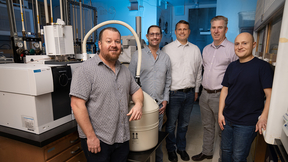Roberts wins NNSA defense program award
 (Download Image)
Don Roberts. Inset: a diagnostic called an all-optical probe dome.
(Download Image)
Don Roberts. Inset: a diagnostic called an all-optical probe dome.
As Roberts explains it, the hydrodynamics experiment studied what happens to metal adjacent to a high explosive detonation.
The multi-million dollar test, conducted last October, was the culmination of three years of work by a team that included 44 people from LLNL, three from the Nevada National Security Site (formerly known as the Nevada Test Site), one from Los Alamos National Laboratory, and six from Great Britain's Atomic Weapons Establishment.
The test utilized several new diagnostic tools, including a diagnostic called an all-optical probe dome. The metal dome was completely designed using an advanced supercomputer simulation software code. It is studded with outlets for fiber optical lines leading to diagnostic instruments, including 72 channels of Photonic Doppler Velocimetry (PDV), a technique invented by LLNL. This test featured the most PDV channels ever used at LLNL.
"There are a number of important and remarkable 'firsts' associated with this experiment," said Mike Dunning, Program Director for Primary Nuclear Design and B Division Leader. "This is the first time an experiment of this type has completely replaced the traditional diagnostic with PDV probes. From a data perspective, this change is akin to replacing 10 snapshots of a horse race with a full movie, so we have much more detailed information about the response of the metal."
"Traditionally, the first use of a new diagnostic on an experiment this complex would require a number of expensive preparatory experiments to ensure successful data collection. Thanks to the tri-lab Advanced Simulation and Computing investments in high performance computing and advanced simulation codes, Don and the team successfully designed this experiment computationally and avoided the financial and schedule costs of additional preparatory experiments," Dunning added. The experiment's components were built and assembled to high-precision tolerances and included the first use of newly designed detonation technology.
Roberts said he was honored "that NNSA recognized the important advance in LLNL's experimental capability that the hydrotest represents. It could not have succeeded without the contributions of dozens of talented scientists, engineers and technicians. This award belongs as much to them as it does to me."
"I feel very fortunate to be at the Laboratory, where we can do work that contributes to national security and that at the same time is creative, exciting, and downright fun," he continued,
"I couldn't be more pleased with the experimental results or more proud of Don and the extended team that made this experiment a complete success" said Dunning. "Bringing together diverse teams of experts to accomplish our programmatic objectives is a hallmark of this Laboratory. In this case, Don assembled a team that spans multiple organizations inside and outside of LLNL and they all have my sincere thanks and admiration."
Recipients of the awards are recognized for going beyond the call of duty in supporting the mission of NNSA's Defense Programs. The selection of the recipients is determined at each site following its own specific criteria.
"We are fortunate to have dedicated professionals who contribute directly to the many successes that NNSA Defense Programs have achieved this quarter. I am once again proud to praise the hard work being done by the men and women throughout the national security enterprise," said NNSA's Don Cook, Deputy Administrator for Defense Programs.
Contact
Robert H Hirschfeld[email protected]
925-422-2379
Tags
NNSAStrategic Deterrence
Featured Articles







